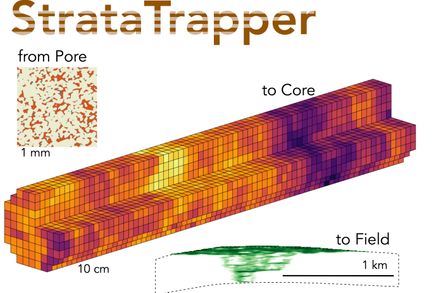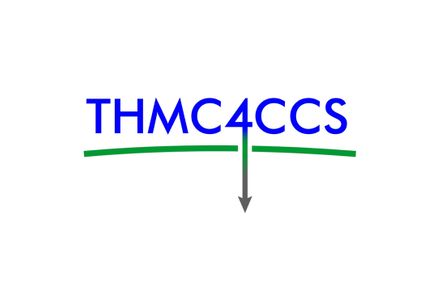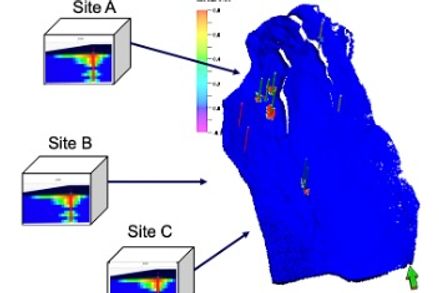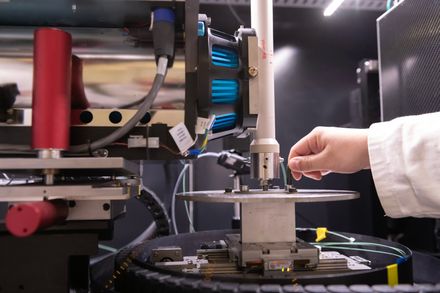We investigate the physics, chemistry, and techno-economics of CO2 storage underground
Our research includes exploring fundamental pore scale fluid dynamics, developing digital rocks analysis techniques, increasing the accuracy of field scale reservoir simulation, and evaluating the feasibility of scaling up CO2 storage to climate relevant scales.
Our Research Projects

StrataTrapper Advanced Modelling of CO2 Migration and Trapping

THMC4CCS: ThorougH experiMental and numerical investigation of Coupled processes for geologiC Carbon Storage
Results
- Showing results for:
- Reset all filters
Search results
-
Journal articleAl-menhali A, Menke H, Blunt MJ, et al., 2016,
Pore Scale Observations of Trapped CO2 in Mixed-Wet Carbonate Rock: Applications to Storage in Oil Fields
, Environmental Science & Technology, Vol: 50, Pages: 10282-10290, ISSN: 0013-936XGeologic CO2 storage has been identified as a key to avoiding dangerous climate change. Storage in oil reservoirs dominates the portfolio of existing projects due to favorable economics. However, in an earlier related work (Al-Menhali and Krevor Environ. Sci. Technol. 2016, 50, 2727−2734), it was identified that an important trapping mechanism, residual trapping, is weakened in rocks with a mixed wetting state typical of oil reservoirs. We investigated the physical basis of this weakened trapping using pore scale observations of supercritical CO2 in mixed-wet carbonates. The wetting alteration induced by oil provided CO2-wet surfaces that served as conduits to flow. In situ measurements of contact angles showed that CO2 varied from nonwetting to wetting throughout the pore space, with contact angles ranging 25° < θ < 127°; in contrast, an inert gas, N2, was nonwetting with a smaller range of contact angle 24° < θ < 68°. Observations of trapped ganglia morphology showed that this wettability allowed CO2 to create large, connected, ganglia by inhabiting small pores in mixed-wet rocks. The connected ganglia persisted after three pore volumes of brine injection, facilitating the desaturation that leads to decreased trapping relative to water-wet systems.
-
Journal articleBoon M, Bijeljic B, Niu B, et al., 2016,
Observations of 3-D transverse dispersion and dilution in natural consolidated rock by X-ray tomography
, Advances in Water Resources, Vol: 96, Pages: 266-281, ISSN: 0309-1708Recent studies have demonstrated the importance of transverse dispersion for dilution and mixing of solutes but most observations have remained limited to two-dimensional sand-box models. We present a new core-flood test to characterize solute transport in 3-D natural-rock media. A device consisting of three annular regions was used for fluid injection into a cylindrical rock core. Pure water was injected into the center and outer region and a NaI solution into the middle region. Steady state transverse dispersion of NaI was visualized with an X-ray medical CT-scanner for a range of Peclét numbers. Three methods were used to calculate Dt: (1) fitting an analytical solution, (2) analyzing the second-central moment, and (3) analyzing the dilution index and reactor ratio. Transverse dispersion decreased with distance due to flow focusing. Furthermore, Dt in the power-law regime showed sub-linear behavior. Overall, the reactor ratios were high confirming the homogeneity of Berea sandstone.
-
ReportBudinis S, Krevor S, Mac Dowell N, et al., 2016,
Can technology unlock unburnable carbon?
In 2015, the Conference Of the Parties in Paris (COP21) reached a universal agreement on climate change with the aim of limiting global warming to below 2 °C. In order to stay below 2 °C, the total amount of carbon dioxide (CO2) released, or ‘carbon budget’ must be less than 1,000 gigatonnes (Gt) of CO2. At the current emission rate, this budget will be eroded within the next thirty years. Meeting this target on a global scale is challenging and will require prompt and effective climate change mitigation action.The concept of ‘unburnable carbon’ emerged in 2011, and stems from theobservation that if all known fossil fuel reserves are extracted and converted to CO2 (unabated), it would exceed the carbon budget and have a very significant effect on the climate. Therefore, if global warming is to be limited to the COP21 target, some of the known fossil fuel reserves should remain unburnt.Several recent reports have highlighted the scale of the challenge, drawing on scenarios of climate change mitigation and their implications for the projected consumption of fossil fuels. Carbon capture and storage (CCS) is a critical and available mitigation opportunity that is often overlooked. The positive contribution of CCS technology to timely and cost-effective decarbonisation of the energy system is widely recognised. However, while some studies have considered the role of CCS in enabling access to more fossil fuels, no detailed analysis on this issue has been undertaken.This White Paper presents a critical review focusing on the technologies that can be applied to enable access to, or ‘unlock’, fossil fuel reserves in a way that will meet climate targets and mitigate climate change.The paper includes an introduction to the key issues of carbon budgets and fossil fuel reserves, a detailed analysis of the current status of CCS technology, as well as a synthesis of a multi-model comparison study on global climate change mitigation strat
-
Journal articleAl-Menhali AS, Krevor S, 2016,
Capillary trapping of CO2 in oil reservoirs: observations in a mixed-wet carbonate rock
, Environmental Science & Technology, Vol: 50, Pages: 2727-2734, ISSN: 1520-5851Early deployment of carbon dioxide storage is likely to focus on injection into mature oil reservoirs, most of which occur in carbonate rock units. Observations and modeling have shown how capillary trapping leads to the immobilization of CO2 in saline aquifers, enhancing the security and capacity of storage. There are, however, no observations of trapping in rocks with a mixed-wet-state characteristic of hydrocarbon-bearing carbonate reservoirs. Here, we found that residual trapping of supercritical CO2 in a limestone altered to a mixed-wet state with oil was significantly less than trapping in the unaltered rock. In unaltered samples, the trapping of CO2 and N2 were indistinguishable, with a maximum residual saturation of 24%. After the alteration of the wetting state, the trapping of N2 was reduced, with a maximum residual saturation of 19%. The trapping of CO2 was reduced even further, with a maximum residual saturation of 15%. Best-fit Land-model constants shifted from C = 1.73 in the water-wet rock to C = 2.82 for N2 and C = 4.11 for the CO2 in the mixed-wet rock. The results indicate that plume migration will be less constrained by capillary trapping for CO2 storage projects using oil fields compared with those for saline aquifers.
-
Journal articleKrevor S, Reynolds C, Al-Menhali A, et al., 2016,
The impact of reservoir conditions and rock heterogeneity on CO2-Brine multiphase flow In permeable sandstone
, Petrophysics, Vol: 57, Pages: 12-18, ISSN: 1529-9074 -
Conference paperAl-Menhali A, Krevor S, 2016,
The impact of crude oil induced wettability alteration on remaining saturations of CO<inf>2</inf> in carbonates reservoirs: A core flood method
Oil is an essential commodity in modern economies but the magnitude of carbon emissions associated with its consumption is significantly increasing the challenges of climate change mitigations. Carbon storage is well recognized as an important technology for CO2 emissions reduction on industrial scales. Observations and modeling have shown that residual trapping of CO2 through capillary forces within the pore space of saline aquifers, characterized as water-wet, is one of the most significant mechanisms for storage security and is also a factor determining the ultimate extent of CO2 migration within the reservoir. In contrast, most of the major CO2 storage projects in operation and under construction are in depleting oil reservoirs utilizing CO2 for enhanced oil recovery (EOR). Carbon utilization and storage has a significant energy and economic benefits and is considered as an important component in achieving the widespread commercial deployment of carbon storage technology. However, there are no observations characterizing the extent of capillary trapping of CO2 in mixed-wet carbonate systems, a characteristic of most conventional oil reservoirs in the world. In this work, residual trapping of supercritical CO2 is measured in water-wet and mixed-wet carbonate systems on the same rock sample before and after wetting alteration with crude oil. In particular, CO2 trapping was characterized before and after wetting alteration so that the impact of the wetting state of the rock is observed directly. A reservoir condition core-flooding laboratory was used to make the measurements. The setup included high precision pumps, temperature control, stir reactor, the ability to recirculate fluids for weeks at a time and an X-ray computed tomography (CT) scanner. The wetted parts of the flow-loop were made of anti-corrosive material that can handle co-circulation of CO2 and brine at reservoir conditions. The measurements were made while maintaining chemical equilibrium between t
-
Conference paperDjabbarov S, Jones ADW, Krevor S, et al., 2016,
Experimental and numerical studies of first contact miscible injection in a quarter five spot pattern
Copyright 2016, Society of Petroleum Engineers. We quantify the impact of mobility, simple heterogeneities and grid orientation error on the performance of first contact miscible gas flooding in a quarter five spot configuration by comparing the outputs from experimental and numerical models. The aim is to quantify the errors that may arise during simulation and to identify a workflow for minimizing these when conducting field scale fingering studies. A commercial reservoir simulator was validated by comparing its predictions with the results obtained from physical experiments. An uncorrelated, random permeability distribution was used to trigger fingering in the simulations. The physical experiments were carried out using a Hele-Shaw cell (40x40cm) designed and constructed for this study. The impact of a square low permeability inclusion (20x20cm) on flow was investigated by varying its permeability, location and orientation. For lower mobility ratios (M=2 to M=10) the commercial numerical simulator was able to reproduce the experimental observations within the uncertainty range of the permeability distribution used to trigger the fingers, provided a nine-point scheme was used for the pressure solution. At higher mobility ratios (M=20 to M=100) the grid orientation effect meant that the simulator overestimated the areal sweep even when a nine-point scheme was used. The introduction of a square, low permeability inclusion near the injection well reduced the discrepancy between experimental and numerical results, bringing it back within uncertainty limits in some of the cases. This was mainly because the real flow was then forced to move parallel to the edges of the Hele-Shaw cell and thus parallel to the simulation grid. Breakthrough times were well predicted by the numerical simulator at all mobility ratios.
-
Conference paperLi X, Yi T, Giddins M, et al., 2016,
A novel approach for waterflood management optimisation using streamline technology
This paper presents a new streamline-based workflow to cover the two main aspects of waterflood management optimisation: infill drilling well location identification and injection rate allocation. Streamline properties are used in every step of the evaluation and decision-making process in the workflow. A novel ranking scheme, weighted by streamline 'remaining mobile oil in pattern', is developed in this study. The well ranking criteria are not only based on the properties of individual well completion cells as in a traditional quality map, but also account for connectivity between injector/producer pairs. In such a way, candidate producers at high-quality map locations, but with poor connectivity or limited swept area, can be screened out. The other main component of the workflow is to perform dynamic pattern injection reallocation in response to the changed well pattern resulting from newly introduced producers. A unique insight for utilization of a multi-zone waterflood for a vertically heterogeneous field is also provided. 2D and 3D heterogeneous models were used to develop and validate the workflow for its general implementation on real field models. The final oil recovery and net present value (NPV) analysis show that the oil recovery can be increased significantly compared to traditional optimisation methods.
-
Conference paperAl-Menhali A, Krevor S, 2016,
The impact of crude oil induced wettability alteration on remaining saturations of CO<inf>2</inf> in carbonates reservoirs: A core flood method
Oil is an essential commodity in modern economies but the magnitude of carbon emissions associated with its consumption is significantly increasing the challenges of climate change mitigations. Carbon storage is well recognized as an important technology for CO2 emissions reduction on industrial scales. Observations and modeling have shown that residual trapping of CO2 through capillary forces within the pore space of saline aquifers, characterized as water-wet, is one of the most significant mechanisms for storage security and is also a factor determining the ultimate extent of CO2 migration within the reservoir. In contrast, most of the major CO2 storage projects in operation and under construction are in depleting oil reservoirs utilizing CO2 for enhanced oil recovery (EOR). Carbon utilization and storage has a significant energy and economic benefits and is considered as an important component in achieving the widespread commercial deployment of carbon storage technology. However, there are no observations characterizing the extent of capillary trapping of CO2 in mixed-wet carbonate systems, a characteristic of most conventional oil reservoirs in the world. In this work, residual trapping of supercritical CO2 is measured in water-wet and mixed-wet carbonate systems on the same rock sample before and after wetting alteration with crude oil. In particular, CO2 trapping was characterized before and after wetting alteration so that the impact of the wetting state of the rock is observed directly. A reservoir condition core-flooding laboratory was used to make the measurements. The setup included high precision pumps, temperature control, stir reactor, the ability to recirculate fluids for weeks at a time and an X-ray computed tomography (CT) scanner. The wetted parts of the flow-loop were made of anti-corrosive material that can handle co-circulation of CO2 and brine at reservoir conditions. The measurements were made while maintaining chemical equilibrium between t
-
Conference paperAgada S, Kolster C, Williams G, et al., 2016,
Modelling basin-scale CO2 storage in the Bunter Sandstone of the UK Southern North Sea
In this paper, a reservoir simulation model of the large-scale Bunter Sandstone in the UK Southern North Sea is used to evaluate the dynamics of regional CO2 plume transport and storage. We have tested the sensitivity of injection capacity to a range of target CO2 injection rates and the number of sites at which injection is deployed. In addition to geology, the model is constrained by local bottom-hole-pressure (BHP) limits and site spacing. Large-scale pressure buildup limitations and the impact of brine production on storage capacity are also evaluated. Furthermore, monitoring of the CO2 plume at multiple injection sites indicates important subsurface controls on plume migration in the context of short-term (approx. 50 years) and long-term CO2 storage (approx. 1000 years).
This data is extracted from the Web of Science and reproduced under a licence from Thomson Reuters. You may not copy or re-distribute this data in whole or in part without the written consent of the Science business of Thomson Reuters.



